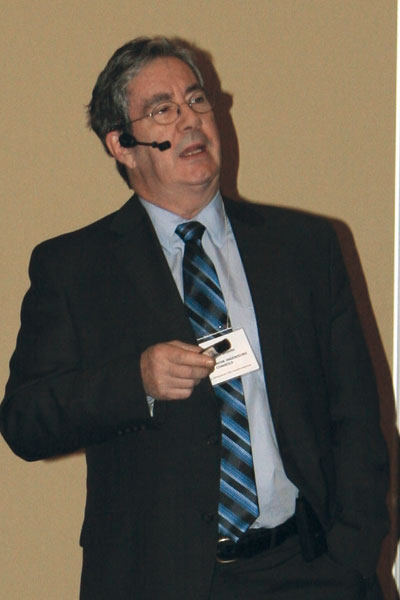
Heating with Biomass
April 1, 2011
By Martine Frigon
More than 100 people attended a daylong seminar in December 2010 to learn about the woody biomass industry and biomass heating.
More than 100 people attended a daylong seminar in December 2010 to learn about the woody biomass industry and biomass heating. The meeting took place in St-Georges de Beauce, a town located between Quebec City and the border with Maine, and was planned by Development PME Chaudière-Appalaches, an organization that promotes entrepreneurship in the region. The eight speakers included researchers, biomass system consultants, manufacturers, and a spokesperson from the Quebec government. They talked about forest biomass as a substitute for fossil energy and how to realize a successful biomass or bioenergy project.
 |
|
| Researchers Evelyne Thiffault from Natural Resources Canada’s Canadian Forest Service (left) and Luc Desrochers from FPInnovations (right) both spoke at the seminar.
|
The attendees were a diverse bunch, including several public building managers who were looking for a solution to high fuel costs, biomass system manufacturers, and woodlot owners and managers. The latter group, who are mainly under the authority of their regional woodlot owners organizations, asked many questions about the harvesting process and about available timber that hasn’t been sold because of the lack of demand from sawmills. Attendees were given a complete overview of the requirements, regulations, and fibre supply related to installing a successful biomass heating system.
 |
|
| Jacquelin Goyette, forest engineer from Groupe INfor Inc., says that the older a fossil fuel heating system, the more compelling it is to look for a conversion to biomass. Advertisement
|
Although the forest industry is one of the main industries in the region, second to manufacturing, there is little Crown land in Chaudière-Appalaches. Its 15,216 km2 mainly comprises private woodlots, of which about 85% are smaller than 800 ha. In fact, only 10.5% of the region is land that belongs to the Quebec government. The harvest opportunity in this region is estimated at 2,179,875 m3/year, whereas 1,266,500 m3 was harvested in 2008–2009, according to the Quebec Ministry of Natural Resources, the Quebec Forest Industry Council, and a local organization that supports and promotes private woodlots.
According to speaker Luc Desrochers, an FPInnovations researcher, 555,480 dry tonnes of biomass could be available in this area, representing huge potential. “During the last recent years, we have harvested only 40% of the forest residues available,” he says.
The best use for biomass is in heating. “That is where we have to put emphasis,” declares Evelyne Thiffault, a research scientist with the Canadian Forest Service. However, she adds that wood residue harvesting is not appropriate everywhere. Depending on the soil type, it could cause risks for ecosystem function, erosion, compaction rutting, and nutrient loss. “Biomass harvest should not be made on peat bogs, rugged slopes, sandy grounds, and soils in which there is a lack of calcium and magnesium,” she says.
 |
|
| Attendees and speakers included Jean-François Côté, from Consultants Forestiers DGR; Jean Desrosiers, from Écocentre Valbio; and Renaud Savard, president of the consulting firm Gestion conseils PMI.
|
There is no doubt that changing a heating system that currently runs on fuel oil or natural gas to forest biomass requires good planning. In Quebec, this kind of heating system is regulated just as any other, with specific inspection requirements according to boiler type and capacity.
Some provincial government programs under l‘Agence d’efficacité énergétique du Québec (AEE) provide grants that can help to cover some of the costs. According to Nicolas Laflamme, AEE spokesperson, the heavy oil consumption reduction program and another program based on forest biomass conversion may be suitable for applications from building or plant managers who want to convert the current heating system.
According to speaker Jacquelin Goyette, forest engineer for Groupe INfor, the supply of raw material is just as important as the heating system. He told the attendees, many of whom were interested in becoming biomass suppliers, to use existing plants, warehouses, and equipment when possible, for better cost control.
 |
|
| Attendees included Raynald Pouliot, from Groupement forestier de Bellechasse (left), and Gaétan Deschesnes, from the Syndicat des propriétaires forestiers de la région de Québec (right).
|
The Amqui Hospital was given as an example from among several recent biomass projects in Quebec. Renaud Savard, president of consulting firm Gestion conseils PMI, explained the project, which was completed in 2009. This 118,403-square-foot hospital, located in eastern Quebec, is heated by two biomass boilers of 800 and 500 kW.
For biomass, softwood tree crowns that are not harvested and sold are taken from a forest management unit located between Matane and the New Brunswick border, through an agreement with the Quebec Ministry of Natural Resources and the Cooperative forestière de la Matapedia.
This amounts to a volume of 10,300 tonnes/year. A Morbark chipper mounted with a Serco 270 loader is the only equipment used to process the biomass. The biomass is then transported to a warehouse located 32 km from the hospital and stored to reduce moisture levels. The Cooperative’s management learned this process during a trip to see biomass use in Finland. It is a great success story for Savard, who adds that other projects for public buildings in eastern Quebec may begin in the coming years.
Print this page